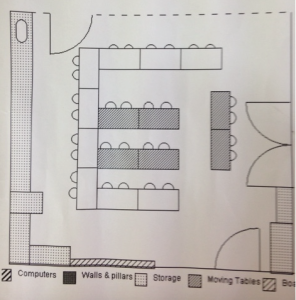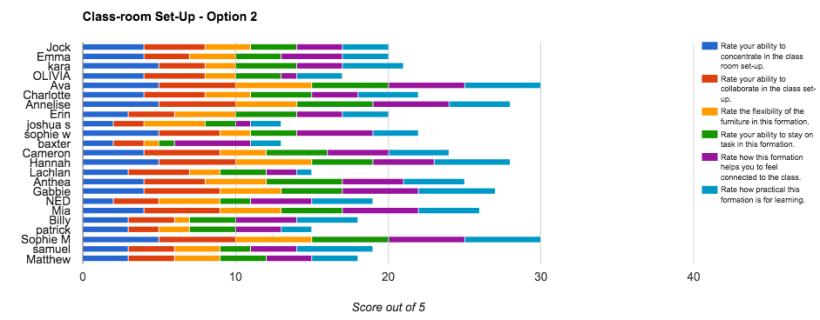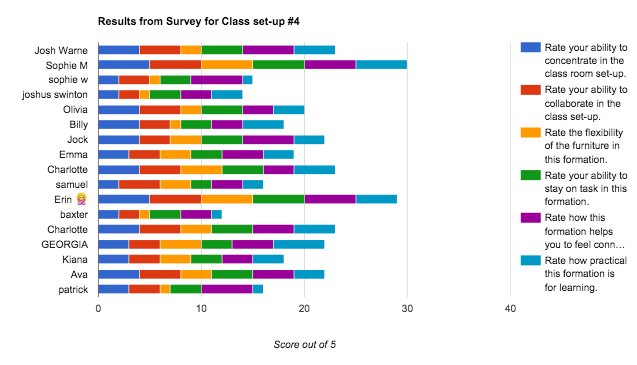OUTCOMES What data are important. How data inform continuous school improvement. How to analyze all types of data for continuous school improvement. How to work through a “problem” with data—getting to contributing causes. Everyone understands—
Author: chantellemorrison
Changing a classroom culture – Part 3 – A 2015 Reflection
One of the aspects of our classroom culture that students said they’d like to change was the desk arrangements. Some students said that the current arrangement “… did not make them feel part of the class.”
Whilst conducting their collaborative research, a couple of students found a variety of different arrangements for us to try. As a class, we decided to trial each arrangement per day for a week and evaluate the arrangements at the end of each day. Students voted on the order in which we should trial the arrangements. I created a Google Form using criteria our class had discussed and posted it on Edmodo at the end of the day.
Day 1
Here are the results for the first arrangement:

As you can see, the data was quite varied. However, we can see that this arrangement is generally not flexible but quite helpful for students to feel connected to the rest of the class. I was surprised that so many students rated this formation quite high for collaboration but then realised that many of them didn’t know what collaboration actually was.
Day 2
It’s important to note that, I actually arranged the desks after students had left of an afternoon. I tried to place students with at least 1 other person they were comfortable with. Here is the second arrangement we trialled and the subsequent survey results:
Concentration, flexibility and practicality all ranked highly in this formation. Results for Ability to stay on task were mixed as they were in the pervious arrangement.
Day 3
By day 3, students were commenting about how they looked forward to the change each day. Here’s the next arrangement and survey results: (NOTE: I was more strategic about student placement this time)

From these results, we can see that students rated flexibility and collaboration lower which is surprising given that the design is quite collaborative. There were mixed results for practicality as in the previous survey.
Day 4
On Day 4, I was a little more thoughtful about the large groups we had and arranged students accordingly. We didn’t have much time in class on the first day so this arrangement was held over 2 days.

I was surprised a how low students rated this arrangement overall as they seemed much more collaborative and on-task over that time. Students did feel more connected to the class though.
Day 5
I think we were all ready for the final arrangement – me = for my arm muscles and students= they were over the survey. For the final day, I asked students to arrange the desks themselves. They needed to choose one person who they hadn’t sat next to yet and mark the spot they were choosing on the plan.


This arrangement rated the mostly highly out of all of the configurations. Concentration and collaboration were both rated highly as was practicality.
Only one question now remains – what do we decide to do with this data?
Changing a Classroom Culture – Part 2 – A 2015 reflection
An aspect of the classroom culture that I wanted to improve was student agency. I decided on a 4-pronged approach:
- Ensure students set personal goals and requested regular feedback for those goals
- Help students to learn feedback protocols in order to give effective peer feedback
- Have a no-hands-up climate
- Ensure there are opportunities in which students have to problem solve
On day 1, I set the stage. In the middle of the day, once we had a bit of an idea about each other, I set a SOLE-based task using Google Advanced Power Search. I implored to myself that I would allow students to get stuck and that I wouldn’t rescue them when they were. Research shows that when people are able to problem-solve themselves out of sticky situations, their self-esteem improves. You can see the break-down of that Day 1 Lesson.
Also on the first day, I showed my new class Austin’s Butterfly and we discussed how a growth mindset would influence our work. The Austin’s Butterfly clip also provides examples of helpful and effective peer feedback.
I have been doing ‘no hands-up’ for about 7 years. However, I decided to use a random-name-picker app to choose the students who would respond. This ensured (for the most part) that students would have something to contribute to the lesson. I also integrated the phrase “If you did know, what would you say?” for those who couldn’t formulate a response.
We began to do Drop Everything and Write (DEW) a couple of times a week. During DEW time, students write silently for 10-15 minutes and then share with peers. I provide students with a stimulus they can use but, essentially, they can write about whatever they want. The most important aspect of DEW is that students set a goal for themselves and then ask their peers to SHOW them where in their writing they have achieved that goal. This has also helped students to really pay attention to each other.
All of these strategies have been so effective thus far. Any other suggestions?
Changing a Classroom Culture – Part 1 – A 2015 reflection
At the moment, I’m spending the remainder of 2015 on contract and filling in for other teachers who are going on long-service leave. It’s very interesting to spend a significant amount of time in a variety of different learning spaces with in the one school.
On Day One of this term, I sat down with my new upper primary class and went through some important information for the week. When I mentioned that one of the things we’d be doing was setting up Edmodo, audible groans filled our learning space. When I enquired into this response, one student spoke on behalf of the class; “We don’t like Edmodo,” he said. I was naturally curious; I had never encountered a group of students who didn’t like Edmodo.
As they’d just returned from holidays and possibly because I’m a new teacher to these students, there was an atmosphere of demotivation and a serious lack of agency. As expected on day 1, students found it difficult that I (someone new) expected them to initiate their learning and be engaged and I was finding the current classroom climate was stopping deep learning from occurring.
As is my practice, I put it to my new, albeit temporary class. We sat together in a circle and discussed the current classroom culture and the learning blocks. Of course, students brought up the usual blocks to learning; not being on-task, disrespect, silliness, etc. What was interesting were some of the comments that I hadn’t heard before…
“I don’t feel like we’re a class with this current furniture set-up.”
“I would feel more on-task if we could have fitness first thing in the morning.”
“I’d like to start the day with circle time.”
I was thrilled to receive such helpful feedback. But, I knew this wouldn’t be enough. I allocated 30 mins in clock partners to research Effective Learning Environments further and present it back to our class. The results were interesting.
Fake Language? How To Know If You’re A User.
“You are not only responsible for what you say, but also for what you do not say.” Martin Luther
Throughout this year, I seem to be using fewer words. One — I don’t need to talk as much; I seem to be spending much more time listening, Two — I seem to be reading more than I’m writing; I’m in absorption mode. Having spent more time listening and absorbing, I’ve begun to notice the language we use, especially words that tend to be overused. I’ve also noticed that many of us users haven’t thought about the meaning behind our words. Despite the fact that the language choices we make (and the hidden meanings behind those language choices) are vital.
Have you ever noticed the titles of the ‘goodies’ and ‘baddies’ from the TV show Get Smart? The ‘goodies’ were named ‘Control’ and the ‘baddies’ were named ‘Chaos’ (spelled Kaos). Consider for a moment the hidden message here. Control = good, chaos = bad. Wouldn’t you love to have overheard the conversation that occurred behind the naming of these two groups!
Alternatively, consider Orwell’s thoughts on the use of language to control the mind and exude power over others. In my experience, it appears to be that those who use the correct buzzwords are those with the power; making others around them feel inferior and out-of-the-loop. Check out the website below and consider the ways in which we use ‘Doublespeak’ (Orwell’s term).
http://www.damronplanet.com/doublespeak/
We often talk about the importance of our organisations having a “common language”. Generally, what people mean by that is that when Person A is talking about [insert overused term here], Person B creates the same association with that word as the speaker and thus better communication ensues. Let’s test how common our language really is. Humour me for a moment and take out a writing implement. Write down these words and then the immediate association you have with these words (NB Don’t think too hard about them and definitely don’t google them):
- Outcomes
- Results
- Innovation
- STEM
- Wellbeing
If you would, choose 1 word and post on Twitter why that one word changes when applied to learning with the #commonlanguage and @notosh . I’ll collate the data and post the results on back on Twitter under the same handles.
All of the terms above are currently buzzwords in the education space but what do they really mean? What do they mean to you, your context and the wider context? Here’s an idea — In the next meeting with your colleagues, conduct the same activity and share what was written down. This would be a great way to determine genuine common language and terms that need defining as well as develop collective empathy.
I encourage us all to compare the various meanings and, perhaps, set ourselves and our teams a mission to find the most appropriate term according to what it is we all really mean.
Another great article to read about the power of words is this one below:
https://uxplanet.org/weak-words-kill-experiences-3c1b48960ce0#.kl5u43j9e
Three Reasons We All Need To Have A Amateur Mindset
Amateurs, on the other hand, make mistakes often and freely; undeterred and focussed on the ever-elusive prize ahead.
I’ve been thinking a lot about amateurs of late… as I’m about to become one again. Just take a moment to reflect on the last time you were a novice. Was it last year? Five years ago? Twenty years ago?
Back at school, we were used to being the amateur but, especially as teachers, we tend to be more comfortable in the “expert” phase of our life seasons.
I’ve had quite a number of careers – outdoor adventure leader, teacher, salesperson, fitness instructor, TV presenter and now… consultant AND mother. That’s a lot of new stuff to learn. But, why should we bother being a novice again? Why shouldn’t I rest on my laurels after all of the effort I’ve gone to becoming an expert in my field?
- Amateurs Prioritise Growth (Eckert, 2016)
In his book, The Novice Advantage, Eckert categorises educational novices into 3 distinct characters:
- The Beginning Novice – one who is inexperienced yet enthusiastic
- The Experienced Novice – one who is experienced yet still passionate about learning new things
- The Perpetual Novice – one who continually challenges oneself to move out of his/her comfort zone
Where do you fit in this list? There is, however, important aspects that these different archetypes have in common – they continue to develop as a learner through rising above setbacks, continuing to be curious and innovating. The novice understands that they will never “get there”… because “there” doesn’t exist.
2. Amateurs Are More Motivated
Have you ever noticed how amateurs are curious? Our 4 year-old wants to know the answer to any and every question. In fact, toddlers ask around 400 questions per day.

When I was beginning my career in the TV industry, I wanted to know everything. I read ratings reports and newspaper articles on new programs that were being developed. I discovered producers and uncovered their contact details. I watched advertisements and quiz shows with a new awareness. I read autobiographies of television personalities to discover their secrets. I even drove 8 hours every Saturday for a term, whilst working full-time, to nurture my presenting skills.
You see, amateurs tend to try anything and everything with audacious disregard for time and space (Merredin, 2012). Amateurs understand that they need to keep motivated in order to learn more… that they haven’t (and may never… hopefully never, reach a pinnacle). Because they often treat their work like a hobby rather than a “job”, they’ll happily continue to craft their skills for hours/days/months on end like a kid learning to ride a bike. It’s astonishing how amateurs find “extra” time to hone their skills.
3. Amateurs Make More Mistakes
…and thus, continue to have a Growth Mindset about their failings. Amateurs understand that mistakes are part of the learning process and they are less attached to perfection. Dweck (2014) calls this the “Power of Not Yet”. Ever notice how perfectionists find change difficult? They don’t want to take risks because they’re afraid to make mistakes… Perhaps, mistakes may damage their professionalism or even their profession. Amateurs, on the other hand, make mistakes often and freely; undeterred and focussed on the ever-elusive prize ahead. They allow mistakes to make them stronger rather than be damaged by them.
May I encourage you… (not actually a question #justsaying) Find something in 2017 in which you can be an amateur – or, maybe, just make that your attitude.
Skills That Require No Talent – Work Ethic
This is my second post in the series of ‘Skills That Require No Talent’. Last post, I discussed the importance of being on time. In this week’s post, I discuss Work Ethic.
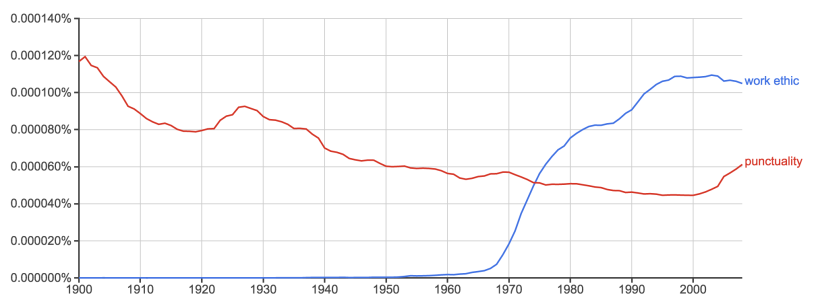
Work Ethic is something that is often discussed but what does it actually mean to have ‘Work Ethic’. The term was even used in the mainstream until the mid 1950s. Strangely enough, the term is often linked to Protestants- as in ‘protestant work ethic’ – coined by the sociologist Max Weber in 1904. Weber’s thoughts were that a protestant work ethic is a moral code in which workers demonstrate their righteousness through diligence in their work.
But how might this look in 2016 and beyond. These days, work is often more (or less in some perspectives) than a calling and more of an ability to be useful. Since the Industrial era, man has been able to improve his/her social status through usefulness and strong work ethic; climbing the ladder and driving his/her own destiny and success.
We also have the added conflict of’ finding balance’ and ‘slowing down’. Does ‘climbing the ladder of success’ mean that we need to spend endless hours at work? How does one ‘climb the ladder’ and keep a healthy work-life balance?
Whitmore (2015) suggests here that work ethic is developed through 7 elements: professionalism (including your dress), respectfulness (grace under pressure), dependability (and stability), dedication (aim for ‘outstanding’), determination (solve problems), accountability (take responsibility) and humility (acknowledge others). These require no extra time on a worker’s part. Others (Jenkins, 2016; Young, 2016) mention integrity, discipline and persistence.
Let’s keep the conversation going. What are the most important factors of work ethic for you?
Ten Skills That Require No Talent – Part 1 – Being On Time

Earlier this year, I posted an image entitled ‘Ten Skills That Require No talent’. It went gang-busters so I thought I’d flesh out some of the ideas.
Being on time
Being on time is harder now more than ever. Yet it should be easier – we have so many tools at our fingertips to help us be organised. Trying to predict the traffic, getting the kids dressed, getting your spouse to move faster than a tortoise… it all adds up to you being late. So how do we ensure we get where we need to be on time.
- Value Others – Remember that the time of other people/person you will be meeting is just as important as your time. He/She/They have also battled against the odds to try and ensure that you aren’t waiting around for them. Time is precious and valuing the time of others let’s them know that they are precious, too.
- Get organised ahead of time – If you aren’t sure where you are going or how long it will take to get there, search it up on Google Maps the day before and then add on 15 minutes for parking. Factor in how long it takes the kids to get ready and set them a timer giving a reward for those who can beat the timer. If you all get to your destination on time or early, you can use the time to have a play.
- Be prepared the day before for a morning meeting – I like to place my clothes in the bathroom the night before so I don’t waste time choosing my outfit when I’m trying to get ready to go. It’s helpful to have any meals you need with you prepared the night before, too.
Hopefully, these 3 tips will help strengthen your ‘being on time’ muscles.
🙂
Algorithmic Thinking + Literacy = ?
Since attending the GAFE PD at Sacred Heart a couple of weeks ago, algorithmic thinking has been on my mind (yes, I am a total nerd!). I attended a session with the fabulous, Dr Rebecca Vivian that focused on how to implement algorithmic thinking in practical ways.
We’ve been studying number patterns in Mathematics so this workshop was brilliant timing, allowing me to implement ideas straight away. We’ve also been focusing on writing information reports. An idea began to boil in my mind… what if instead of designing success criteria, students could use algorithmic thinking to create a flow chart for a successful information report.
I decided that I would attempt this task through Literacy Rotations. This meant that while other students were engaged in their specific rotational task, I could explicitly teach students in small groups about flow charts and the symbols… and it would link with the algorithmic work we were doing in Maths… even better!
I distributed to the students a template of the flow chart symbols (an example of the symbols but my example was much simpler) accompanied by an information report work sample (from ACARA work samples) which we’d previously studied and labelled.
As a small group, we then worked through the symbols and their meanings and I modelled how they might start their flow chart (Are you writing about something people will want to read? Yes? No?). In their small group, students then continued these draft diagrams. Here’s an example of a starting point.

From here, students began using the drawing tool in Google Docs to create flow charts that could be added to and adjusted more easily. Check out the example below:

This continues to be a work in progress and these flow charts will develop as we continue to delve deeper into interesting and effective information report writing.
Scavenger Hunts with Google
PRIOR TO THE SESSION
Today I tried something quite new (what a surprise!) and it was also quite complex. After reading Stephanie Perretta’s blog about Creating Self-Checking Scavenger Hunts with Google, I gave it a go myself. Stephanie has set up the resources for a first-timer so beautifully – thanks, Stephanie. Her instructions are so detailed that, for once, I had to read through something in a systematic way in order to accurately replicate the process.
Since we’re studying the Order of Operations (AKA BIDMAS, BODMAS, PEDMAS, BIMDAS etc.) and it’s a fairly linear process, I decided to create my scavenger hunt around this topic. I also wanted to add more than YouTube clips for remediation, too – this required some trouble shooting as I also wanted to use PlayPosit and Brainpop.

Setting it up was quite a process and, for once, I knew I actually had to test it myself as there were so many variables in play. Luckily, I did as there were a few aspects that didn’t quite “add up”.
However, not everything went exactly to plan but I’m a life-long learner with a growth mindset. Thus, I reflect on my experiences and work out how I can improve them next time;)
JUST BEFORE THE DAY
I set the QR codes in place the afternoon before – ready for our lesson after recess on the following day. Then, at about 2.45pm the day before, a student came up to me saying “I found this QR code on the ground.” Annoying. I then had to search through the classroom to find where it may have been missing from.
JUDGEMENT DAY
I had prepped the students about the scavenger hunt just prior to the session. After recess, the first thing I did was provide students with a rubric and ask them to self-assess their knowledge of each aspect so far. I then asked the students to add a Chrome extension – The QR Code Extension – via an announcement on our Google Classroom page. Following this, students were free to scan in the QR code (strategically placed on the back of the rubric) and complete the first quiz.
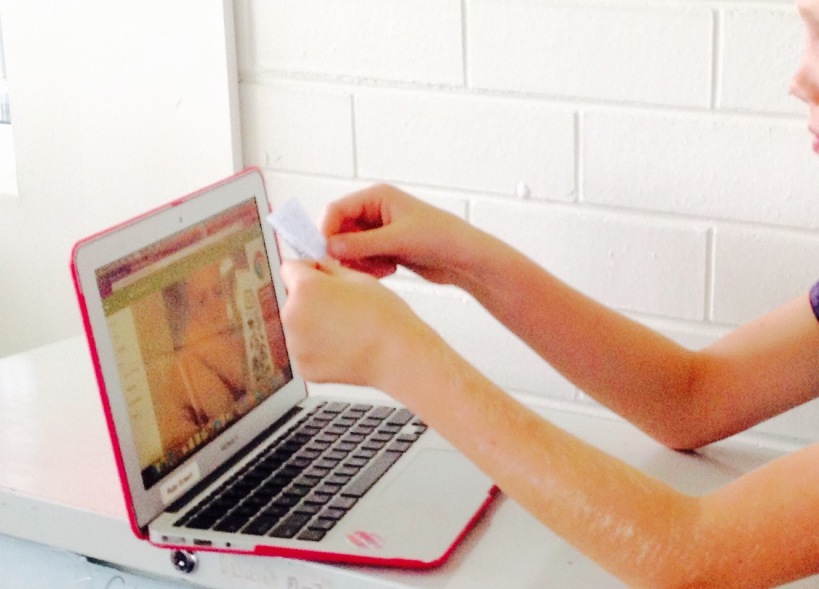
Here’s where things got a bit crazy. I didn’t consider that from that point at least half the class would be going to one site (the next question) and the rest would be going to the second site (the remediation for Q1). This had many students waiting around and also resulted in QR codes going missing.
We troubled-shot (?) through this quite quickly though and then we were off. There were a couple of other speed-humps though that I’ll navigate more carefully next time:
- Students neglected to actually press ‘Submit’ and therefore, they got confused and just started following friends around.
- Students neglected to return QR codes to their hiding place which meant that QR codes went missing.
- Some students didn’t watch the remediation videos which meant that they just re-did the final quiz until they finally chose the correct option rather than learning how to do it accurately.
- I neglected to mention that PEDMAS, BODMAS and BIDMAS are all the same thing which confused students.

WHAT WILL I DO TOMORROW?
I’m going to start our Maths session explicitly teaching BIDMAS (order of operations). Then students will pick-up where they left off in the scavenger hunt.
On Wednesday, we’ll debrief the whole process in our class meeting so we can make it better for everyone next time.
Thanks again, Stephanie Perretta, who inspired me to think outside the box.
